What is coastal erosion?
Many features of the coast have been created by erosion. This is when the sea wears away the land. Coastal erosion creates features like caves and sea stacks.
In this article you can find out:
- Different stages of coastal erosion
- How sea stacks are formed
- How tides can be used to generate electricity
- Scottish wildlife at sea
This resource is suitable for Landscapes topics for primary school learners.
Video - Coastal erosion
Join Isla and Connor as they explore features of coastal erosion on a journey from Stromness in Orkney to Scrabster in the north of mainland Scotland.
Watch this short video to find out about features of coastal erosion.
ISLA: Thanks for letting me tag along to visit your grandparents. I’ve really enjoyed Orkney! It has such a fascinating history I didn’t know before. Like the Vikings that settled here!
Makes sense since we’re so close to modern day Norway and the rest of Scandinavia, where the Vikings came from.
The Vikings were masters of the sea, which they’d have to be in these rough waters. The ancient people who lived on Orkney were brilliant sailors.
CONNOR: Speaking of travelling across the sea, here comes the ferry!
ISLA: Woohoo! I love being on the water. Did you know this water is really special? The Pentland Firth has some of the most powerful tides in the world. That’s why Orkney is an important centre for renewable energy research.
Because the tides move so fast they generate a lot of energy, which we can convert into electricity.
At high tide, the water levels rise, and the water level drops again at low tide.
You can see this on a beach by how far the water comes up on the sand or stones, and at the bottom of cliffs where the low tide will expose wave cut platforms, the rock left underwater when the sea has eroded or worn away the rock above it.
Here at Pentland Firth, the tides move really fast, especially combined with high winds. They can reach 30 kilometres per hour. The faster they are, the more power they have to erode the rocks.
CONNOR: I can think of other ways we can see evidence of that power too!
Oh yeah, look at that monster sea stack! That’s The Old Man of Hoy. It’s one of the UK’s tallest sea stacks. It’s only a few hundred years old.
Maps from a couple of centuries ago show there was a complete headland there…which means that the sea stack was still part of the mainland. The land in between has now eroded away leaving the stack behind.
People climb it and write their name in a log book at the top!
ISLA: What! Ooh, I don’t think I want to climb that. It doesn’t look easy.
Connor, wow! It’s a minke whale. Keep an eye out for orcas and basking sharks too. Aren’t they amazing?
CONNOR: That was an awesome ferry journey.
ISLA: I want to see more of this amazing coastline. There’s a great walk around here.
Here we are!
CONNOR: Another sea stack - with an arch in it too.
ISLA: Yep, the cracks in the rock are how erosional features like The Old Man of Hoy start. The different features here show the different stages of coastal erosion. It starts with a crack in the rock, which widens into a cave over time. Eventually, the sea wears right through the cliff face creating an arch. The arch gets too wide to support the land above it and the top of the arch collapses, leaving a stack behind. That too will fall down, leaving just a stump - the bit of rock that remains underwater.
CONNOR: Just think that every time those waves hit that rock, they’re changing the face of this coastline.
ISLA: I love this rugged coastline, it’s so beautiful, but you know what? I’d like to visit a bit of coast that’s more relaxing. Beaches perhaps?
CONNOR: Definitely!
The power of the sea
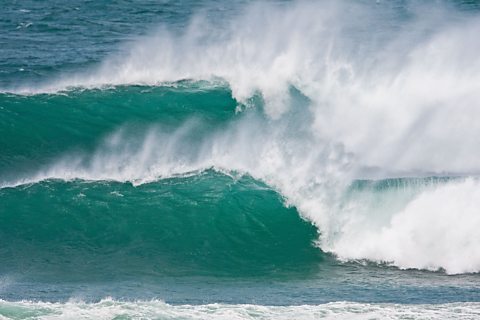
- Scotland is surrounded by sea. The boundary between the sea and land is called the coast or coastline.
- Waves crashing up against the land cause erosionWearing away over time.. Over time, all this erosion can change the shape of the coastline.

Features of coastal erosion
Erosion can create caves, arches, stacks and stumps along a headland.
A headland is a narrow piece of land that sticks out from the coast into the sea. Headlands are made of hard rock. They form when softer rock on either side is eroded. A headland is usually high up and has a steep drop.
- Waves crash onto the headland and wear away the rock creating cracks.
- Caves are formed when waves force their way into the cracks. The water contains sand and other materials that grind away at the rock until the cracks become a cave.
- Over time, waves may eventually break through to the other side of a cave forming an arch.
- The arch will gradually become bigger until it can no longer support the rock above it. When the arch collapses, it leaves the headland on one side and a stack (a tall column of rock) on the other.
- The stack will be eroded at the bottom. This weakens the stack and it will eventually collapse to form a stump.
Coastal erosion features in Scotland
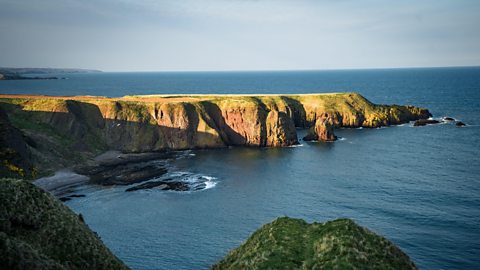
Image caption, Headland
A headland is a piece of land on the coast that sticks out into the sea, like this rocky headland on the north east coast of Scotland. (Pavel Kasak / Alamy Stock Photo)
Image caption, Caves
Caves are formed when waves force their way into cracks in a cliff face. There are natural caves in the Maw Skelly headland in Arbroath (above). One of these caves has even eroded to form an arch at the end of the headland. (Stephen Finn / Alamy Stock Photo)
Image caption, Arch
Over time, water may eventually break through to the other side of a headland forming an arch. This arch near Wick, Caithness, is called The Needle Eye Rock. (David Robertson / Alamy Stock Photo)
Image caption, Sea stack
The Old Man of Hoy is one of the tallest sea stacks in the UK. A sea stack is a tall column of rock that was once part of a headland. (David Chapman / Alamy Stock Photo)
1 of 4
How is a wave-cut platform formed?
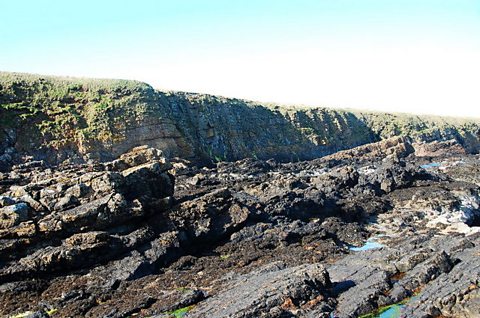
Another example of coastal erosion is a wave-cut platform. This is a flat area in front of a cliff, just below the low tide mark. This is the level where the tidesThe rise and fall of the sea caused by the gravitational pull of the moon. Most places on the coast have two high tides and low tides each day. is at its lowest.
Wave-cut platforms are formed when waves erode a cliff and leave a flat platform behind.

What are tides?
- Tides are the rising and falling levels of the ocean’s surface caused by the gravitational pull of the moon. The change between high and low tide happens twice a day.
- tidesThe rise and fall of the sea caused by the gravitational pull of the moon. Most places on the coast have two high tides and low tides each day. in the ocean are caused by the gravityA force that pulls things towards the centre of a mass. Gravity is much stronger for bigger masses like planets and stars. of the moon pulling the Earth towards it.
- Where oceans face the moon, the water is pulled most and builds up in a bulge. This is a high tide. The Earth is pulled towards the moon more than the ocean on the opposite side of the planet. This causes another high tide.
- As the moon moves around the planet, these tides move around with it, causes two high tides and two low tides each day.
- This moving water has a lot of kinetic energyEnergy that an object possesses because of its movement. A ball being thrown through the air has kinetic energy because it is moving. When water moves this is also an example of kinetic energy. that can be used to generate electricity.
- The Pentland Firth has some of the most powerful tides in the world. That's why Orkney is an important centre for renewable Something that does not run out when used. energy research.
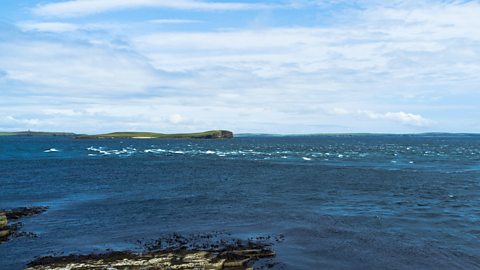
Scottish sea life
Discover some of the wildlife you might spot around Scotland's coast.
You can read about the whales and dolphins spotted off Scotland's west coast on Â鶹Éç News: The whales which have visited Scotland for 20 years
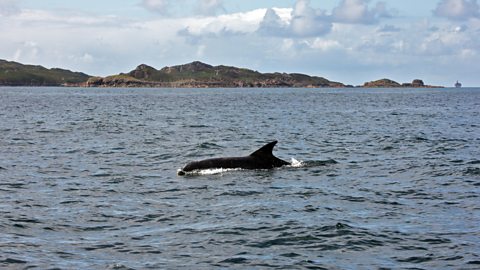
Image caption, Minke whales
Minke whales can be spotted around the coast of Scotland. They eat small fish and plankton in shallow water so can sometimes be spotted from headlands and ferries. This Minke Whale was spotted between the islands of Mull and Iona in western Scotland. (Lynne Sutherland / Alamy Stock Photo)
Image caption, Orcas
Orcas are well-known for their unique black and white pattern and big dorsal fins (the one on their back). They are often known as 'killer whales' but they're not a whale at all! They're actually a dolphin. This group of orcas (a pod) was photographed near the Shetland Islands. (David Havel / Alamy Stock Photo)
Image caption, Basking sharks
Basking sharks are the second largest fish in the world and they can sometimes be spotted swimming around the west coast of Scotland in summer. This basking shark is feeding on plankton in waters around the Hebrides. (robertharding / Alamy Stock Photo)
1 of 3
Coastal living with Cumbrae Primary School
Spot some more coastal wildlife as Cumbrae Primary School explain why they think living on the coast is brilliant.

Key words about coastal erosion
- coast - Where land meets sea. Also known as coastline.
- shore - The land along the edge of a sea, lake, or wide river.
- tides- The rising and falling levels of the ocean’s surface caused by the gravitational pull of the moon.
- renewable energy - An energy source that can be used again and again. Renewable energy includes solar, hydro and wind energy.
- high tide - When water covers most of the shore after rising to its highest level.
- low tide - When water retreats (goes back) to its lowest level, moving away from the shore.
- erosion - The wearing away of pieces of rock, soil or other solid materials.
- wave cut platform - A flat area in front of a cliff, just below the low tide mark. They are formed when waves erode the cliff and leave a flat platform behind.
- headland - An area of land that sticks out from the coast into the sea.
- cave - A natural opening in the Earth's surface. Most caves are created when water erodes or dissolves rock, creating an opening or passage.
- arch - A curved opening with a bridge, roof or wall above it. They can be formed in headlands when a cave has been eroded by the sea.
- sea stack - A tall column of rock. They are formed when erosion causes an arch in a headland to collapse.
- stump - A small pillar of rock left behind when a sea stack has collapsed.
Test your knowledge
Quiz
Challenge

Design a Viking longboat.
In the video at the top of the page, Isla explained that Vikings settled in Orkney hundreds of years ago.
The Vikings were expert sailors and were very good at shipbuilding. Their longboats could survive difficult sea journeys - like journeys from Norway to Scotland!
Try designing and building your own Viking longboat.
If you want to find out more about the Vikings in Scotland, take a look at these guides: Vikings in Scotland
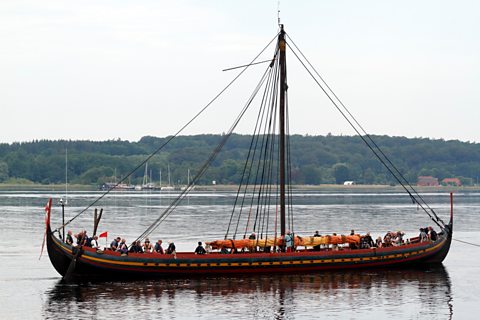
More about Vikings
Why did the Vikings raid? videoWhy did the Vikings raid?
Find out about what happened when the Vikings went raiding with Bitesize - 2nd Level History.
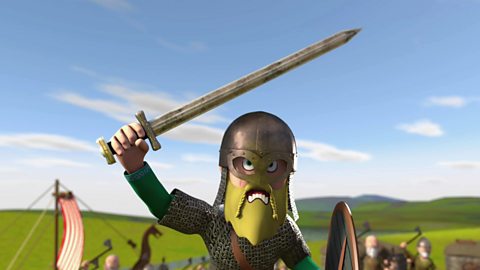
Where did the Vikings travel to? videoWhere did the Vikings travel to?
The Vikings explored far and wide by dragging their boats over land. Find out more with Bitesize- 2nd level History.
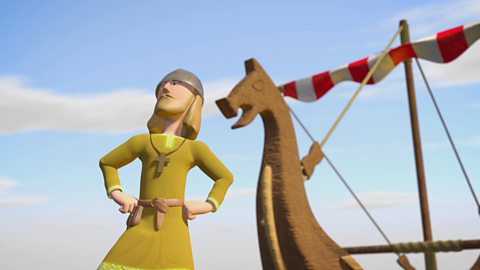
Life in a Viking settlement. videoLife in a Viking settlement
Find out about life in a Viking settlement with Bitesize - 2nd level History.

Renewable electricity
Find out how we can use waves and tides to generate renewable electricity.
Tidal energy. revision-guideTidal energy
Find out how tidal power can be used to generate electricity.
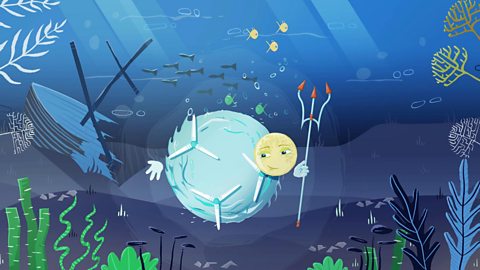
Wave energy. revision-guideWave energy
Find out how wave energy uses the power of the sea to generate electricity.
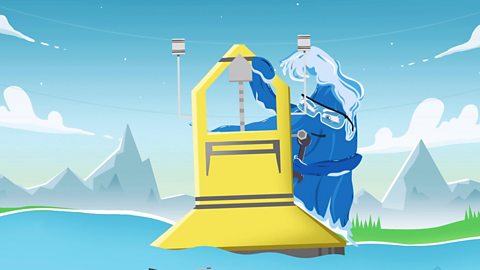
What is renewable and non-renewable energy? revision-guideWhat is renewable and non-renewable energy?
What are the different types of renewable and non-renewable energy?
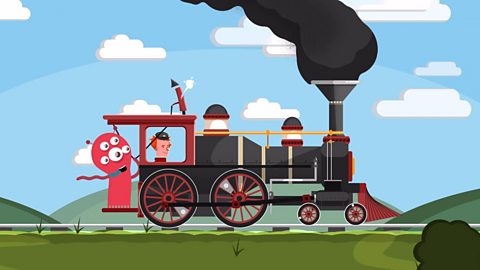
More on Landscapes
Find out more by working through a topic
- count18 of 25

- count19 of 25
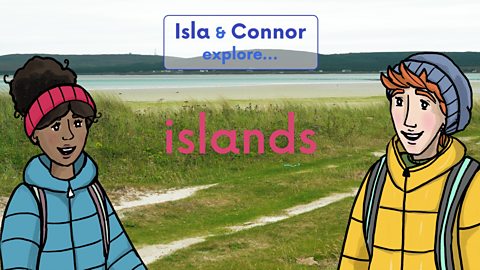
- count20 of 25
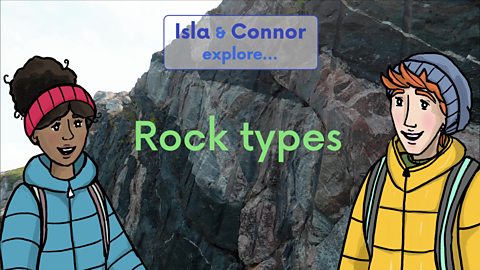
- count21 of 25

